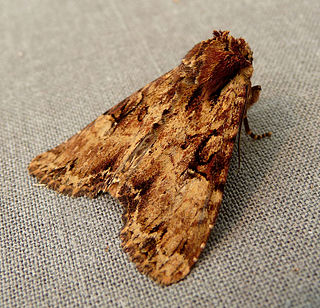Apamea or Apameia is the name of several Hellenistic cities in western Asia, after Apama, the Sogdian wife of Seleucus I Nicator, several of which are also former bishoprics and Catholic titular see:

Apamea sordens, the rustic shoulder-knot or bordered apamea, is a moth of the family Noctuidae. The species was first described by Johann Siegfried Hufnagel in 1766. It is distributed throughout Europe, east across the Palearctic to Central Asia and to China and Japan. It also occurs in North America.
Apamea Ragiana – Apamea Rhagiana, Apamea Raphiana, or Apameia Rhagiane; previously, Arsace, Khuvar, and Choara – was an ancient Hellenistic city of Choarene, Media, according to Strabo 500 stadia south of the Caspian Gates, southeast of Rhagae. The city was founded after the Macedonian conquest of Persia. The city is also mentioned by Ammianus Marcellinus. The precise location of Apamea is not known, but it is certainly in Iran; the ruins have not been found.

Apamea Myrlea was an ancient city and bishopric on the Sea of Marmara, in Bithynia, Anatolia; its ruins are a few kilometers south of Mudanya, Bursa Province in the Marmara Region of Asian Turkey.

Apamea Cibotus, Apamea ad Maeandrum, Apamea or Apameia was an ancient city in Anatolia founded in the 3rd century BC by Antiochus I Soter, who named it after his mother Apama. It was in Hellenistic Phrygia, but became part of the Roman province of Pisidia. It was near, but on lower ground than, Celaenae (Kelainai).

Apamea or Apameia was a Hellenistic city on the left bank of the Euphrates, opposite the famous city of Zeugma, at the end of a bridge of boats connecting the two, founded by Seleucus I Nicator. The city was rebuilt by Seleucus I. The site, once partially covered by the village of Tilmusa, Şanlıurfa Province, Turkey, is now flooded by the lake formed by the Birecik Dam.
Apamea or Apameia was an ancient city – and possibly two ancient cities lying close together – of Mesopotamia mentioned by Stephanus of Byzantium and Pliny as situated near the Tigris near the confluence of the Euphrates, the precise location of which is still uncertain, but it lies in modern-day Iraq.

Apamea, on the right bank of the Orontes River, was an ancient Greek and Roman city. It was the capital of Apamene under the Macedonians, became the capital and Metropolitan Archbishopric of late Roman province Syria Secunda, again in the crusader time and since the 20th century a quadruple Catholic titular see.
Apamea or Apameia was a Hellenistic city in Media founded by Seleucus I Nicator, near Laodicea and Heraclea.. Apamea's precise location is not known, but it was located near Nahavand.Apamea is old Phrygien Kelainai in Afyonkarahisar Province Turkey.(Near Leodekia-Denizli Province)
Apamea or Apameia is an ancient Hellenistic city described by Pliny in Sittacene, which was surrounded by the Tigris. Its precise current location is not known.

Apamea is a genus of moths in the family Noctuidae first described by Ferdinand Ochsenheimer in 1816.

Apamea lithoxylaea, the light arches, is a moth of the family Noctuidae. The species was first described by Michael Denis and Ignaz Schiffermüller in 1775. It is distributed throughout Europe, the Caucasus, Armenia, Asia Minor and Turkey, and ranges east to the Altai Mountains.
Apamea inficita, the lined Quaker is a moth of the family Noctuidae. The species was first described by Francis Walker in 1857. It is native to North America, where it can be found from Newfoundland west to British Columbia, north to the Yukon and the Northwest Territories, and south to Colorado.

Apamea zeta is a moth of the family Noctuidae. It has a Holarctic distribution, and can be found throughout the Northern Hemisphere. It occurs throughout Europe and the northern half of North America.

Apamea furva, the confused, is a moth of the family Noctuidae. The species was first described by Michael Denis and Ignaz Schiffermüller in 1775. It is found throughout Europe. In southwestern Europe it is primarily montane. It is found as far north as the Arctic Circle. From Europe its range extends to Siberia, Turkey, Iran, Kyrgyzstan, Mongolia and Xinjiang in China.

The Battle of Apamea was fought on 19 July 998 between the forces of the Byzantine Empire and the Fatimid Caliphate. The battle was part of a series of military confrontations between the two powers over control of northern Syria and the Hamdanid emirate of Aleppo. The Byzantine regional commander, Damian Dalassenos, had been besieging Apamea, until the arrival of the Fatimid relief army from Damascus, under Jaysh ibn Samsama. In the subsequent battle, the Byzantines were initially victorious, but a lone Kurdish rider managed to kill Dalassenos, throwing the Byzantine army into panic. The fleeing Byzantines were then pursued, with much loss of life, by the Fatimid troops. This defeat forced the Byzantine emperor Basil II to personally campaign in the region the next year, and was followed in 1001 by the conclusion of a ten-year truce between the two states.

Apamea epomidion, the clouded brindle, is a moth of the family Noctuidae, sub-family Hadeninae. The species was first described by Adrian Hardy Haworth in 1809. It is found throughout continental Europe, the British Isles, Sweden and Central Asia. It is also found in the Altai Mountains, west Siberia, and in Amur.
Elekosmioi was a town located near the coast of the Propontis in ancient Bithynia, between Cius and Apamea Myrlea.
Homadena was a town of ancient Phrygia on the road from Apamea to Eumeneia, inhabited during Roman and Byzantine times. Its name does not occur in ancient authors but is inferred from epigraphic and other evidence.








